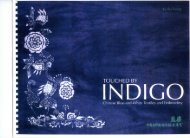2005, Justin Jennings, Kathy L. Antrobus, Sam J. Atencio, Erin ...
2005, Justin Jennings, Kathy L. Antrobus, Sam J. Atencio, Erin ...
2005, Justin Jennings, Kathy L. Antrobus, Sam J. Atencio, Erin ...
You also want an ePaper? Increase the reach of your titles
YUMPU automatically turns print PDFs into web optimized ePapers that Google loves.
284 F current anthropology Volume 46, Number 2, April <strong>2005</strong><br />
Fig. 4. The operational chain for making agave wine.<br />
que with the necessary microorganisms, primarily the<br />
yeast S. cerevisiae (Atacador-Ramos et al. 1996:393), was<br />
placed in the vessel or the pulque was simply left open<br />
to airborne yeasts (Parsons and Parsons 1990 :46, 100).<br />
In most cases, the dregs of the previous batch of pulque<br />
were left in the barrel to stimulate fermentation (Bruman<br />
2000:70; Madsen and Madsen 1979:42; Parsons and Parsons<br />
1990:100).<br />
Roots, herbs, and pieces of agave were sometimes<br />
added to the vats during the fermentation period to<br />
change the brew’s taste (Taylor 1979:31). Fermentation<br />
typically took 3–12 days but could take considerably<br />
longer depending on additives and weather conditions<br />
(Anderson et al. 1946:887; Aasved 1988:365; Parsons and<br />
Parsons 1990:45; Steinkraus 1979:39). Pulque should be<br />
consumed within a few days after fermentation is complete<br />
because “it quickly undergoes a putrescent decomposition<br />
and acquires a most objectionable stench” (Bruman<br />
2000:71; also see Parsons and Parsons 1990:99).<br />
However, Mesoamericans now and in the past had access<br />
to additives, typically strips of bark, that appear to impede<br />
the development of bacteria by lowering the pH of<br />
the pulque. Further, some modern groups extend the<br />
drink’s shelf life by placing hermetically sealed jars in<br />
underground pits. In the best cases these measures allowed<br />
pulque to be stored for up to a month (Dahlin and<br />
Litzinger 1986:731).<br />
grape wine<br />
Grape wine, called tin or geštin in Mesopotamia and ĭrp<br />
in Egypt (Joffe 1998:304; Lesko 1978:3; McGovern 2003:<br />
151), has an alcohol content of 8–14% by volume. The<br />
wild grape subspecies Vitis vinifera sylvestris was the<br />
source of almost all ancient wine and was likely domesticated<br />
in Mesopotamia and the Levant by at least<br />
the fifth millennium BC (McGovern 2003; Renfrew 2003:<br />
57; Zohary 1995:28–30). V. vinifera’s resistance to disease<br />
and cold, its high natural acidity, and its high sugar content<br />
made the species ideal for alcohol production (Kun-
















